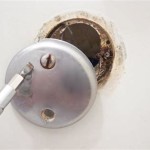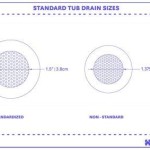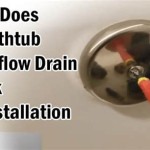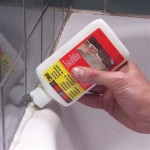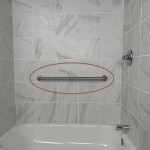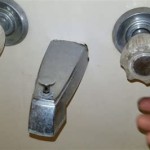What Are The Parts Of A Bathtub Faucet Called? Diagrams Explained
Understanding the anatomy of a bathtub faucet can be useful for various reasons, from identifying the source of a leak to planning a replacement or upgrade. While faucet designs vary, many core components remain consistent across different types. This article provides a detailed overview of the parts of a bathtub faucet, accompanied by explanations and conceptual diagrams to aid comprehension.
A bathtub faucet system generally consists of three main functional units: the spout, the valve (or valves), and the diverter. Each of these units comprises several individual parts working in coordination to deliver water, control temperature and flow, and redirect water to the showerhead when applicable. Exploring each section individually offers a more comprehensive understanding of the entire system.
Understanding the Faucet Spout Components
The spout is the visible part of the faucet that delivers water into the bathtub. Its primary function is to provide a clear path for the water stream from the valve body into the tub. The design and materials of the spout can vary significantly, impacting aesthetics and functionality.
The
spout body
is the main housing, typically made of brass, chrome, or stainless steel. It's the visible part that extends into the tub. Different spout designs exist, including those with a smooth, curved appearance, or those with a more angular, modern look. The material used influences the spout's durability and resistance to corrosion.The
spout aerator
is often found at the tip of the spout. Its purpose is to mix air into the water stream, creating a smoother, more even flow, and often reducing water consumption. Some aerators are also designed to filter out sediment and debris from the water supply, improving water quality. Aerators are typically threaded and can be easily removed for cleaning or replacement.The
spout O-ring
orgasket
is a small, circular rubber or silicone ring located where the spout connects to the valve body. Its function is to create a watertight seal, preventing leaks from occurring at the connection point. Over time, O-rings can degrade and crack, leading to leaks that require replacement of the O-ring or the entire spout assembly.In some designs, the spout may incorporate a
diverter mechanism
. This is more common in tub and shower combination faucets. The diverter allows the user to switch the water flow from the tub spout to the showerhead. While some diverters are integrated into the valve handles, others are located directly on the spout. The discussion of diverters will be covered in more detail later.The
spout nipple
is the connecting piece threaded into the valve body. This is usually a brass or galvanized steel pipe. It provides a secure connection between the spout and the internal plumbing. The spout nipple's length and threading must be compatible with the valve body to ensure a proper fit and a leak-free connection.The
escutcheon
(or flange) is the decorative plate that covers the hole in the wall where the spout or valve stems protrude. They serve an aesthetic purpose, concealing rough edges and creating a finished look. Escutcheons come in various shapes, sizes, and finishes to match the faucet design.Dissecting the Valve Assembly
The valve assembly is the heart of the bathtub faucet, responsible for controlling the water flow and temperature. There are several types of valve systems, the most common being compression valves, ball valves, cartridge valves, and ceramic disc valves. Each type has distinct components and operational mechanisms.
Valve Body:
This is the main housing for the valve mechanism, usually made of brass. It contains the waterways that direct hot and cold water and the mechanisms that control their flow. The valve body is typically concealed behind the wall, with only the valve stems or handles visible.Valve Stems:
These are the threaded rods that connect the handles to the internal valve components. When the handle is turned, the stem rotates, either opening or closing the valve to control water flow. Over time, the threads on the valve stem can become worn, leading to leaks.Valve Handles:
These are the visible controls used to operate the faucet. They come in various styles, from traditional cross handles to modern lever handles. Handles are typically attached to the valve stems with screws or other fasteners. Different handle designs provide varied levels of grip and ease of use.Valve Seats:
These are the stationary surfaces against which the valve washers or seals press to shut off the water flow. Valve seats are typically made of brass or stainless steel and can become corroded or damaged over time, leading to leaks. In some faucet designs, valve seats are replaceable.Valve Washers/Cartridges/Discs:
These are the components that physically block the water flow when the valve is closed. In compression valves, a rubber washer is pressed against the valve seat. In cartridge valves, a replaceable cartridge containing internal seals controls the flow. Ceramic disc valves use two ceramic discs with aligned openings to regulate water flow. These components are prone to wear and are often the cause of leaks.Valve Packing:
This is a material, typically made of graphite-impregnated string or Teflon tape, that is wrapped around the valve stem to create a watertight seal. Packing prevents water from leaking out around the stem. Over time, the packing can dry out and shrink, requiring replacement to stop leaks.Retaining Nuts/Screws:
These are used to hold the valve components together and in place. They are essential for maintaining the structural integrity of the valve assembly and preventing leaks. These nuts and screws should be tightened properly and inspected regularly.Diverter Valve (Integrated or Separate):
In tub/shower combinations, a diverter valve directs the water flow to either the tub spout or the showerhead. This can be integrated into one of the valve handles or be a separate handle. Diverter valves can use various mechanisms, including push-pull levers, rotating knobs, or internal cartridges, to redirect the water flow.The Diverter Mechanism: Sending Water Upward
As previously mentioned, the diverter valve is a crucial component in tub and shower combination faucets. It allows users to conveniently switch the water flow between the tub spout for filling the tub and the showerhead for showering. The diverter mechanism can exist as an integral part of the faucet valve or as a separate component located either on the spout or within the valve assembly.
Diverter Handle/Knob/Lever:
This is the user-operated control used to activate the diverter valve. These controls typically have two positions: one for directing water to the tub spout and another for directing water to the showerhead. The handle may be a simple push-pull knob, a rotating lever, or a more complex multi-position control.Diverter Valve Body:
This is the housing for the diverter mechanism. It contains the internal waterways and moving parts that redirect the water flow. The diverter valve body is typically made of brass or similar corrosion-resistant material.Diverter Valve Piston/Sleeve:
This is the moving part within the diverter valve that physically redirects the water flow. It can be a piston that slides up and down, a rotating sleeve with openings, or a flapper valve that opens and closes different pathways. The design of this component is critical for reliable diverter function.Diverter Valve O-rings/Seals:
These are used to create a watertight seal between the diverter valve components and prevent leaks. These seals are subject to wear and tear and may need to be replaced periodically to maintain proper diverter function.Linkage/Actuator:
This refers to the mechanical connection between the diverter handle and the diverter valve piston/sleeve. This linkage transmits the user's input from the handle to the internal valve, causing it to redirect the water flow. The linkage must be robust and properly adjusted for smooth and reliable operation.Understanding the individual components of a bathtub faucet, including the spout, valves, and diverter, can be invaluable when troubleshooting issues or undertaking repairs. Recognizing the purpose and function of each part enables a more informed approach to maintenance and replacement, potentially saving time and money. While faucet designs can vary, the fundamental principles governing water flow and temperature control remain consistent across different models. Further research into specific faucet models can provide additional detail for specialized repairs.

Bathtub Parts Everyone Should Know About Part Names 2024

Learn How To Remove And Install Various Tub Spouts

Parts Of Shower Valve Name Diagram Linquip

Learn How To Remove And Install Various Tub Spouts

15 Essential Parts Of A Bathtub And How They Work

Bath Tub Spouts The Largest Selection Of On Web

The Diffe Parts Of A Bathtub And How They Work Family Handyman

Ultimate Guide On 24 Parts Of A Bathtub Names Functions Diagram

Polished Chrome Courant 8p8 Ws2 Cospc 1 Handle Tub Shower Trim With Valve Pfister Faucets

Parts Of A Bathtub With Diagram Homenish
Related Posts

